Potpourri
This page contains all manner of things related to Alfred the Great, not suitable for inclusion on previous pages.
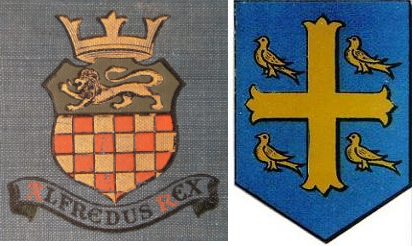
Both of the above are claimed as the arms of Alfred the Great, the arms on the left appear on the covers of the "King Alfred Millenary" and "King Alfred of Blessed Memory" books (See Biographies page). Neither gives any details or history, such as the earliest recorded use of these arms. Coats of arms were generally unknown in England before the Norman Conquest. The heraldic artists of the Medeival period were fond of creating arms for the pre-conquest kings, this may be one such creation. Peter Heylen, in his book "A Help to English History", published in 1640, gives an illustration of these arms and describes them thus: Cheque, Or. and Purpure, on a chief, Sables, a lion passant. gar, of the first. The arms on the right are used by University College, Oxford. Alfred the Great was the supposed founder of the college in 878. These arms were used by Alfred's son Edward the Elder, and are described thus: Azure, a Cross patonce between four Martlets. Or. Edward the Confessor used the same arms, but with five martlets. We know these arms are genuine because the cross and martlets has been found on some of the silver pennies of his reign. Illustration below taken from 'The Coins of England: A Sketch of the Progress of The English Coinage, from the Earliest Period to the Present Time' by Henry Noel Humphreys (1810-1879), published in 1846.

The description reads thus: 'The specimen No.64 shows a coin of this king, which, for the first time exhibits a full figure of the sovereign seated on a throne, holding the orb and sceptre. It is surrounded with EADPRD. REX ANGLO., for "Eadweard Rex Anglorum", the Saxon P being used for W in Edward. The reverse shows the voided cross with martlets in the angles, called the Confessor's arms'.
******************************
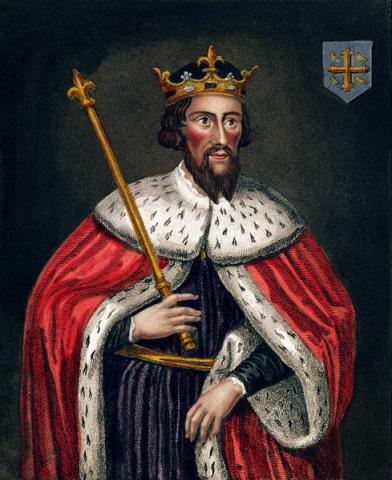
Portrait of King Alfred showing the arms of Oxford University in the top right hand corner.
***********************************
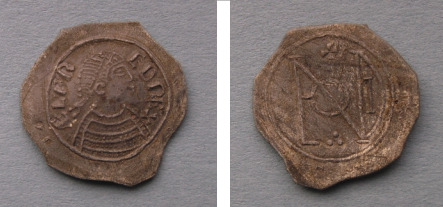
A lead trial- piece of King Alfred, bearing the monogram of London on the reverse. Coins were struck using engraved dies. Die-cutting was carefully controlled to avoid the unauthorised striking of coinage. Die-cutters tested their dies on lead before issuing them to moneyers. Warwick H. Draper, in his book "Alfred the Great" (1901) records that a lead trial-piece, with a defaced head of Alfred was found in St.Paul's Churchyard about 1841, and is preserved in the British Museum. The above piece was recovered from the Thames.
***********************************
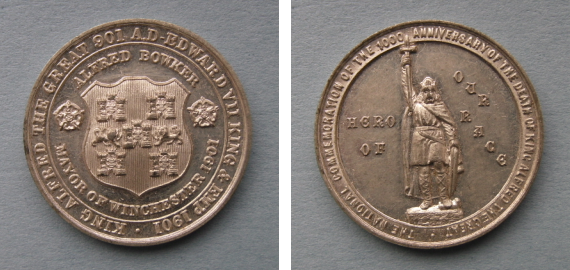
Medal issued in 1901 by Alfred Bowker, Mayor of Winchester, to commemorate the 1,000th anniversary of the death of King Alfred the Great.
***********************************
In 1849 the people of Wantage, Berkshire, celebrated the Millenary of the birth of their most famous son, Alfred the Great. The celebration was largely the work of one man, Martin Farquhar Tupper (1810-1889). He designed two medals, the first, for sale to residents of the town was struck in gold, silver, bronze, and white metal, by J.Taylor, Little Queen Street, Lincolns-Inn. The features of Alfred were collected from coins of the period, a bust at Oxford, and the engraving by Vertue. 100 impressions in base metal were distributed to spectators. The second medal was issued to a privileged set of subscribers. The inscription reads 'AElfred and his children. The British Empire, United States, and Anglo Saxons everywhere. 1849.
***********************************
A medal issued to commemorate the unveiling of the statue of Alfred the Great at Wantage, on the 14th July, 1877, by HRH Prince of Wales. The statue was presented to the town by Colonel Loyd Lindsay, V.C., M.P, of Lockinge House.
************************************
A book published to commemorate the unveiling of the statue of Alfred the Great in Wantage, 14th July, 1877. Printed and published by J. Lewis, Newbury Street, Wantage. The author is anonymous.
********************************
Saint Alfred. Alfred the Great is venerated as a saint by the Catholic Church and the Eastern Orthodox Church, his feast day is 26th October.
*******************************
King Alfred Daffodil. The King Alfred daffodil was bred towards the end of the 19th century by John Kendall; who died in 1890. His sons introduced his creation to the public in 1899 (The Millenary Celebrations). In the Spring of 1899 the King Alfred daffodil received a 1st Class certificate, the highest award granted by the Royal Horticultural Society. The original selling price in 1900 was six guineas a bulb , but a year later the price had dropped to five guineas. The price continued to drop as it went from being a rarity to the standard gold trumpet daffodil. By the 1950s production of the King Alfred bulb had begun to decline as growers switched to new varieties. Only a small amount of the true King Alfred daffodil are still grown; most of the bulbs advertised are actually Dutch Master.
*******************************
Achillea - King Alfred. Achillea is a genus of about 85 plants in the family Asteracea, commonly referred to as Yarrow, or Milfoil. They are hardy herbaceous perennials, mostly from Eastern Europe, and are used mainly for borders or rockeries. Achillea is reputed to be the plant with which Achilles cured the wounds of his soldiers. One variety is named King Alfred.
********************************

King Alfred's Cakes, is one of the names given to the Fungus 'Daldinia concentrica", it lives on dead and decaying wood, especially Ash trees.. It resembles a piece of coal, and one of its common names is Coal Fungus. Another name given to it is Cramp Balls, because carrying it in your pocket was said to prevent or relieve leg cramp. The name King Alfred's Cakes came about because they are said to resemble the cakes that Alfred let burn when he was sheltering in a homestead on the Isle of Athelney. This Fungus is a useful form of tinder for firelighting, and will easily take fire. It burns slowly like charcoal, with a pungent aroma. Once lit it is quite difficult to extinguish.
*******************************
King Alfred's Crown, along with Edward the Confessor's crown survived until the Civil War. After the Execution of Charles 1st in 1649, Cromwell had the entire crown jewels removed and melted down or sold. In the inventory of the Crown Jewels taken by the Order of Parliament in 1649, King Alfred's crown is described thus:- 'King Alfred's Crowne of gould wyer-worke, sett with slight stones, and 2 little bells, 79 and a half ounces at 3 pounds per ounce, 248 pounds. 10s' It is mentioned by Spelman in his "Life of King Alfred", that on the cabinet in which this crown was kept was an inscription to this effect: 'Haec est principalior corona cum qua coronabantur reges AElfredus, Edwardus" and adds that it was "of very ancient work, with flowers adorned with stones of somewhat a plain setting" In the 'Gentlemans Magazine' for August, 1831, an article on 'The Crowns of the Kings of England' says "It is noticed by Mr.Taylor, as a circumstance corroborative of the belief that this was really King Alfred's Crown, that Robert of Gloucester, who wrote in the time of Henry the Third, mentions its preservation in his day: 'Pe pope Leon hym blessede, po he puder coin, And pe kynges cronne of pys lond, pat in pys lond gut ys'.
******************************
The King Alfred Lodge (Masonic) in Weston-super-Mare was founded in 1906, their banner depicts Thorneycroft's statue in Winchester.
******************************

The King Alfred Motor Services in Winchester was a family owned bus company founded by Robert Chisnell in 1920.The buses had a green livery, with a picture of the famous statue on the side. The company ceased in 1973 when it became part of the National Bus Company, and its routes were operated by the Hants and Dorset Bus Company.
******************************

The Dragon of Wessex (above) the banner under which Alfred the Great fought the Danes.
*********************************
After the War of Independance in 1775, one of the first ships to be built by the new government was named "King Alfred".
*********************************
The following items could be classified as memorials, but it was felt that they would be more suited for inclusion on this page.
H.M.S. King Alfred was built by Vickers Ltd, Barrow-in-Furness; laid down in August 1899, and launched on 28th October, 1901. She was a 14,000 ton armoured cruiser of the Drake Class. General characteristics: Length: 500 feet, Beam: 71 feet. Speed: 23 knots, Horsepower: 30,000hp. Armaments: 2xBL 9.2 inch guns in single turrets, 16x BL 6 inch Mk V11 guns in casemates along hull, 12x12 pounder guns. H.M.S. King Alfred saw service in WW1, but on 11th of April, 1918, she struck a mine (or possibly a torpedo) on Loch Swilly and was beached. She was later repaired, but never again entered active service. She was sold for breaking up on 30th of January, 1920. For further details see "The King Alfred Millenary" by Alfred Bowker.

Crest of H.M.S. King Alfred.
A watch chain fob; this would have been worn by someone who had served aboard H.M.S. King Alfred.
**************************************
King Alfred Steamship. The King Alfred Steamship Company was formed by 26 year old Owen Crosby Philipps, later Lord Kylsant, in 1889, to own a ship of the same name. In 1893 the company name was changed to King Line. The "King Alfred" was built in 1889 by the Blyth Shipbuilding Company, Blyth, and weighed 1,137 tons. It was wrecked at South Uist, Hebrides, on April 15th 1894, while on a voyage from Fernandia to Bo'ness, carrying a cargo of phosphate.
***************************************
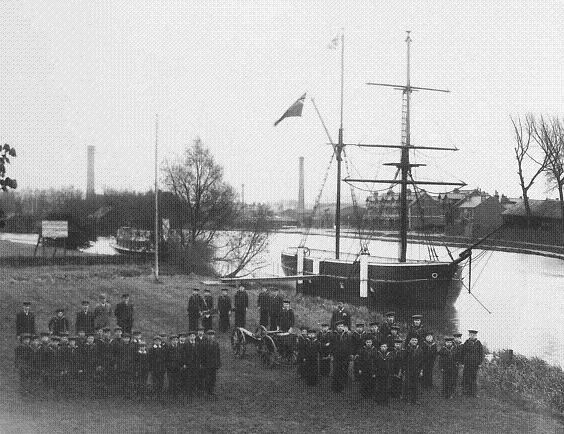
The training ship "King Alfred", on the Thames, at Reading in 1900. (No other details available at present)
***********************************

King Alfred paddle steamer. A paddle steamer named the 'King Alfred' was built in 1905 by the Thames Iron Works; she weighed 120 gross registered tonnes, and her length was 130 feet. She served the London County Council River Thames Service from Greenwich to Hammersmith from 1905 to 1907: afterwards she was sold for service in Memel, Germany, and renamed 'Memel'. Modernised with construction of deckhouses, etc. She survived until 1962 and was scrapped in 1965.
****************************************

The Merchant steamer 'King Alfred' was built by William Doxford and Sons Limited of Sunderland; she weighed 5,272 tons, and was launched in 1919. Her home port was Sunderland. While on route to Halifax, Nova Scotia, she was torpedoed and sank on the 4th of August, 1940, with 8 dead and 31 survivors.
******************************************
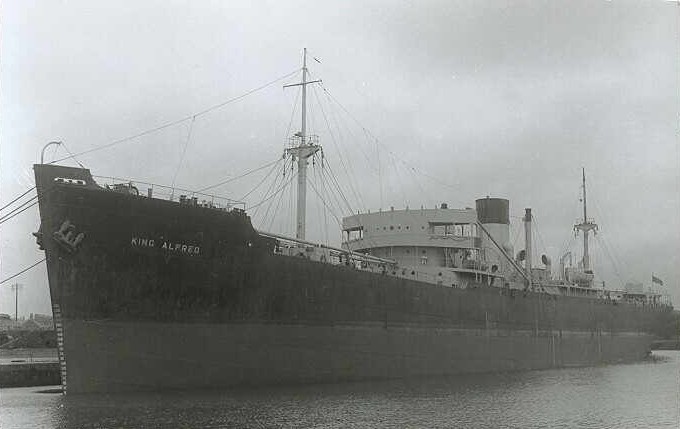
The 'King Alfred', built in 1941 by Greenock Dockyard Company for the Ministry of War Transport, she was first named 'Empire Ray'. In 1945 she was purchased by the King Line and renamed 'King Alfred' She weighed 6,919 tons. She was laid up in 1962, and scrapped in 1963 at Hamburg.
***************************************************
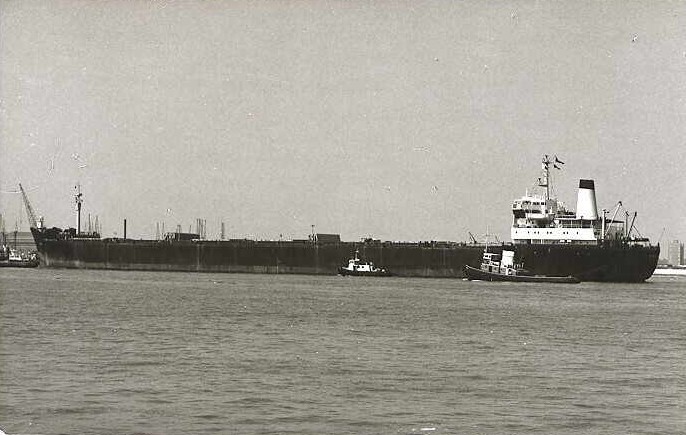
King Alfred . A bulk carrier named the "King Alfred" was built at Eriksberg at Gothenburg : launched on the 2nd April, 1968, and delivered in September of that year; it was owned by British and Commonwealth. It traded in coal and ore.
****************************************
A Barque 'Alfred the Great' was lost off the Ness Lighthouse on Tuesday 28th September, 1886. The ship left Quebec with a full cargo of timber on August 26th. They had moderately fine weather until the 26th when it blew a hurricane, their maintopsail and foreyard were carried away. The gale increased on Monday and they began to take in water and in the evening the stern began to give way. When daylight appeared on Tuesday it was found the cargo was coming out and the ship was breaking up fast; the crew were ordered to take to the lifeboats.
****************************************
The King Alfred Leisure Centre in Hove, Sussex, was requisitioned during the 2nd World War and renamed H.M.S. King Alfred. It became the home to the Royal Naval Volunteer Reserve from 1940 to 1945. It trained over 22,500 naval recruits, including actors Sir Alec Guiness, Sir Michael Hordern, and broadcasters Richard Baker and Sir Ludovic Kennedy. The Present H.M.S King Alfred is situated on Whale Island at Portsmouth, and is one of the largest Reserve Training Centres in the country, with a complement of over 200 reservists.
*****************************************
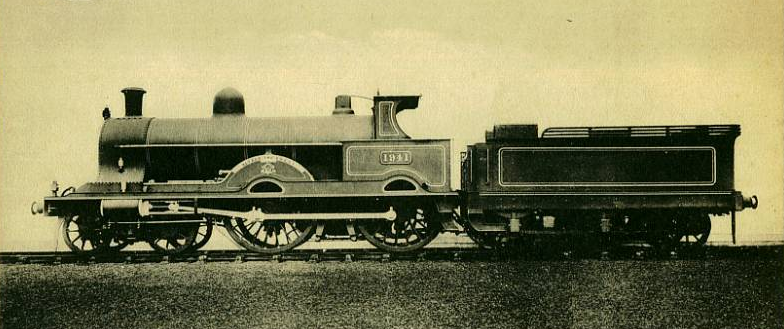
Alfred the Great, locomotive. Between 1901 and 1903 the London & North Western Railway built 40 locomotives known as the Alfred the Great Class. They were a class of 4-4-0 4 cylinder, designed by F.W. Wells (1871-1903). After modification they were known as Benbow Class. Number 1941 was named Alfred the Great, after the grouping in 1923, it was renumbered 5179 by the London, Midland & Scottish Railway.
*****************************************

Alfred the Great, locomotive. In 1951 British Railways introduced a class of locomotive known as Britannia Class, designed by R.A. Riddles; the chosen name was based on a suggestion by Bishop Eric Treacy (1907-1978), a railway photographer. Number 70009 was named Alfred the Great; she was built at Crewe in May 1951, and withdrawn from service in January 1967.
*************************************************
Sir John Millais (1829-1896). An oil painting by Sir John Millais, titled 'The Baptism of Guthren the Dane before Alfred the Great', measuring 39 inches by 49 and a half inches, was sold by Christies, as part of the collection of the late Frederick W. Grafton, of Heysham Hall, Lancaster, on Saturday June 10th, 1890. The painting realised £105.
******************************************
Grosvenor Gallery, London. When the Grosvenor Gallery opened in 1877, one of the exhibits was Count Gleichen's smaller model for his statue of King Alfred, that was unveiled at Wantage, Berkshire, the same year, by his relative, the Prince of Wales.
*****************************************
Sir David Wilkie (1785-1841). An oil on canvas (1806) titled 'King Alfred Burning the Cakes' (private collection).
*****************************************
Mason Chamberlin (1727-1787). A painting (1764) titled 'King Alfred in the Neatherd's Cottage'.
*****************************************
Benjamin West (1738-1820), Historical Painter to the King. An oil painting (1779) titled 'Alfred the Great, dividing his last loaf with a Pilgrim'. In 1784 it was recorded as being in the possession of a Mr. John Boydell, who paid £210 for it.
*****************************************
Alfred Stevens (1817-1875). An oil painting on wood (1848) titled 'King Alfred and his Mother'. Purchased in 1903 by the Tate Gallery.
*****************************************
John Calcott Horsley (1817-1903). An oil painting (1851) titled 'A Model for Alfred's Navy'; shows Alfred approving the model of a ship which he had designed.
*****************************************
Richard Westall (1765-1836). A watercolour (1799) titled 'Queen Judith reciting to Alfred the Great, when a boy, the songs of the Bards describing the heroic deeds of his Ancestors'. The picture was exhibited at the Royal Academy in 1800, and is now in the British Museum.
***********************************************

Samuel Woodford (1763-1870). Alfred the Great, painted 1793.